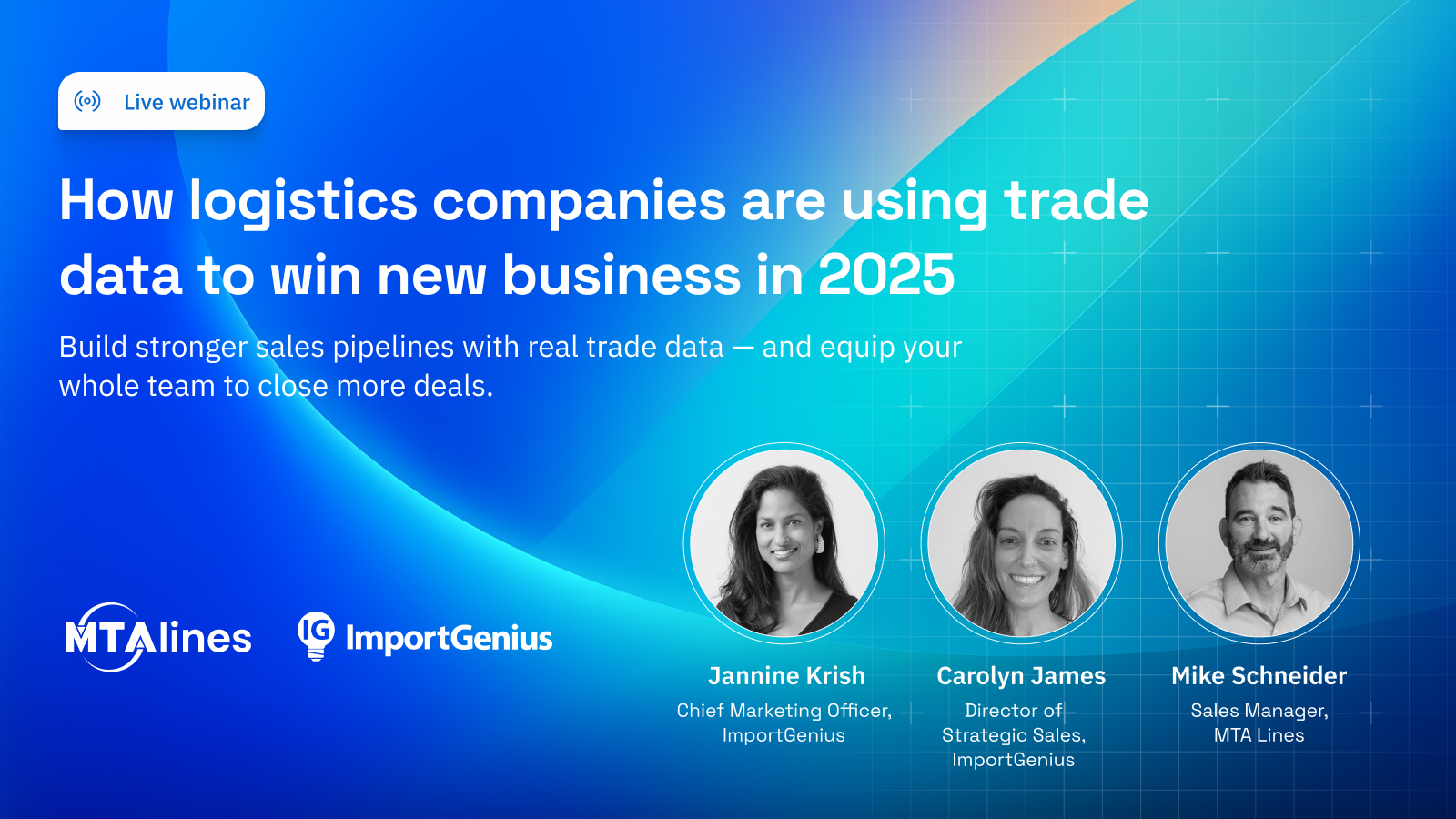Key takeaways
- Trade data is the fastest way to spot shippers that actually need you.
- Panelists showed how trade data for logistics lead generation can slice research time, surface decision‑makers, and shorten freight forwarding sales cycle outcomes.
- Daily‑refreshed U.S. import feeds and AI‑driven company profiles turn raw bills of lading into actionable prospect lists.
- Approximately 70 % of new leads at MTA Lines come from trade data
Why trade intelligence is essential for logistics sales
In a market clouded by tariff uncertainty and packed with competitors, logistics providers need actionable trade intelligence that generates wins
That was the main theme of our recent webinar, featuring ImportGenius’s Chief Marketing Officer, Jannine Krish and Director of Strategic Sales, Carolyn James, along with Sales Manager, Mike Schneider from Midwest Trans-Atlantic Lines.
Their discussion showed how leveraging trade data for logistics lead generation is shrinking prospecting time, shortening sales cycles, and giving forwarders and carriers a clear edge in 2025.
[CTA]
Top pain points slowing down logistics sales teams
Sales and marketing teams in logistics face common pain points:
- Hours lost in manual research and then chasing leads with often outdated or incomplete data
- A crowded market makes prospecting hard to win when you go in cold and less informed
- Longer sales cycles when pitches miss the decision‑maker
- Tariff swings turn reps into unpaid consultants with prospects not wanting to make decisions in these uncertain times
“Not only are logistics companies trying to figure out what to do, their customers are looking to them for answers,” Carolyn observed.
Reps are no longer just moving freight; they’re educators on geopolitics, tariffs, and supply-chain risk: a shift that makes having fresh trade data essential to providing credible, timely advice.
Using trade data to accelerate logistics sales cycles
ImportGenius provides timely customs import data to make outreach sound less like a cold pitch and more like a solution. Its features empowered trade data for logistics lead generation, providing comprehensive insights for outreach.
- Daily data drops: U.S. imports refresh every weekday; global feeds update monthly.
- AI‑driven profiles: Founding history, key products, shipment stats, and verified contacts in one click.
- API & bulk files: Pipe shipments straight into your CRM, so reps discover, tag, and work leads without leaving their dashboard.
- Current‑event pivots: Need a list of shippers rerouting after the Baltimore bridge disaster? Two filters and you’re done.
As Carolyn summed up:
“It’s about turning data into actionable intelligence, not just rows in a spreadsheet.”
That focus helps teams shorten freight forwarding sales cycle milestones from first touch to quote.
From crisis to clarity: How the Baltimore bridge collapse shows the power of actionable trade data
When the Francis Scott Key Bridge collapsed in Baltimore, Carolyn used trade data to respond instantly.
“To be able to go into a database and actually see who imports goods into the Port of Baltimore … and who is going to need help rerouting shipments immediately—that’s something you can do with this data.”
She immediately identified every affected importer, creating a high-value list of businesses in urgent need of rerouting solutions.
This power to act isn't limited to large-scale crises. For sales managers like Mike, it turns any everyday observation into a concrete opportunity.
“I plugged in the company’s name on my phone, pulled up how many shipments they did... who their suppliers were, the volumes, everything. We have unlimited qualified leads at our fingertips, and I already know most of the person’s pain points before I dial.”
Armed with this intel, finding a new lead is no longer a research project but an on-the-spot discovery.
[CTA-2]
See the ROI at MTA Lines
This data-driven approach extends beyond finding leads to crafting the perfect pitch.
With insights into a shipper’s current carriers and transit times, Mike can offer immediate value, solving a problem the prospect likely didn't know they had.
“I might have a faster option that could get your goods here quicker…right now New York is very congested, let’s look at Norfolk,”
Mike tells prospects, turning a sales call into a strategic consultation backed by hard data.
The payoff for this targeted, value-first strategy is clear and quantifiable.
Approximately 70% of MTA’s new leads now originate from trade data. From there, roughly 10% of those prospects advance to rate discussions, with 1–2% converting into closed business.
In a margin-tight logistics market, that predictable performance creates a powerful conversion engine.
Start with a clear question
For teams new to trade data, Carolyn offered straightforward guidance:
“The most crucial advice is to clearly define the problem you are trying to solve with the data.”
Need better leads in Los Angeles? Want to spot importers exposed to the next tariff wave? Anchor your filters there, save your valuable searches to reuse later, and set alerts on critical shipments to get notified the moment they clear customs. Automate delivery into your CRM or a weekly CSV, and track calls‑to‑quotes‑to‑wins.
Refine and repeat.
Closing thought
In a market where uncertainty is the only constant, the winners are the teams that turn fresh trade data into decisive action. As Mike put it, “If you’ve got something to ship, I can move it for you.” With ImportGenius feeding the pipeline, that confidence is grounded in facts, not hope.
Whether your goal is laser‑targeted prospect lists, or to shorten freight forwarding sales cycle metrics across the board, the tools—and the data—are ready. The next move is yours.
[CTA-3]
Ready to dive deeper?

Ready to dive deeper?

See more strategies like these in action

Want the winning 2025 logistics sales strategy?

More blogs & reports





